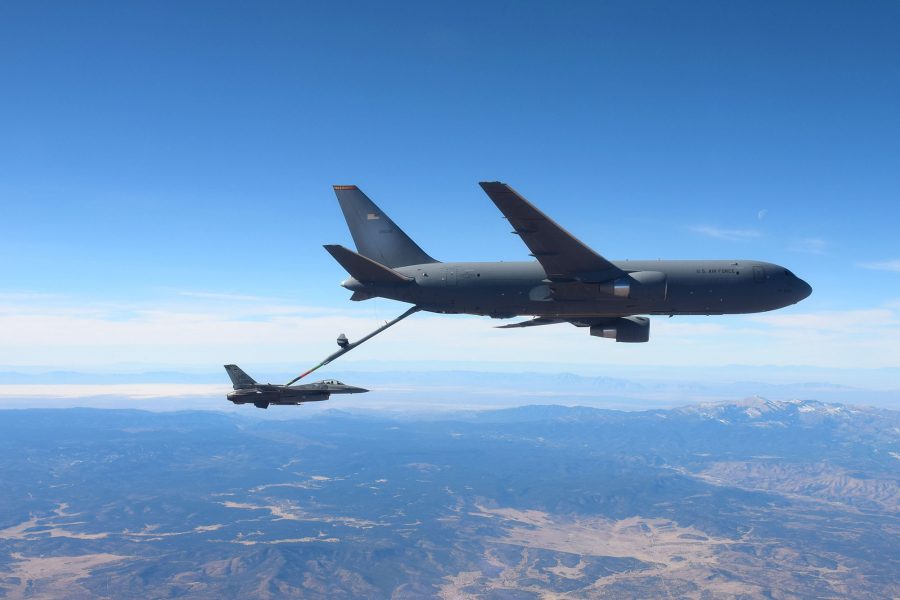The KC-46A is a heavily modified Boeing 767-200ER multirole passenger/cargo-tanker equipped with flying boom and probe/drogue refueling capability using the Wing Air Refueling Pod (WARP) system. It is also equipped for aeromedical evacuation.
KC-46 incorporates the 787’s state-of-the-art cockpit, a fly-by-wire boom, remote boom-operator’s station, advanced self-defensive suite including Large Aircraft IR Countermeasures (LAIRCM), RWR, tactical situational awareness, comms relay hosting, and nuclear/chem/bio hardening. In 2011 Boeing was contracted for 179 KC-46A tankers, the first increment (KC-X), was to replace approximately half of USAF’s KC-135R fleet.

Compared to the 50-year-old KC-135, the KC-46A has more fuel capacity, improved efficiency, and enhanced cargo and AE capability. Like the KC-10, it employs an advanced refueling boom and independently operating hose/drogue system.
The program’s provisioned 767-2C prototype (minus refueling boom) flew on Dec. 28, 2014, and received FAA type certification in 2017 prior to the first production aircraft’s delivery in 2019. USAF awarded the first LRIP contract for 19 aircraft in 2016, and most recently awarded Lot 11 in November 2024, raising the quantity on contract to 158 airframes.
Full-rate production was initially planned for Lot 3 but IOC and full-rate production slipped due to remaining deficiencies with the boom, remote vision system (RVS), and fuel drain lines. USAF accepted Boeing’s revised 3D-RVS design for six color/IR cameras and boom modifications and plans to begin retrofits and initial flight testing in 2026.
KC-46s suffered two refueling-boom related mishaps refueling an F-16 and F-15E in 2024, and the fleet continues to fall significantly short of its target 90 percent mission capable rate. The Wing Aerial Refueling Pods (WARPs) have also faced certification delays due to icing and weight and balance issues. The KC-46 is cleared to refuel receivers in combat (except for the A-10) while awaiting resolution of the final three critical deficiencies. The KC-46 completed developmental testing and entered operational testing in 2019, which USAF now plans to complete in FY26.
The KC-46 is testing a C2 pod which is the first element of the Advanced Battle Management System (ABMS) to network fifth-generation aircraft in high-threat environments and FY25 aims to launch LOS/BLOS secure C2 and situational awareness. The service is considering an upgraded KC-46 as one option for a 75-aircraft “bridge” fleet to a next-generation, possibly stealthy, tanker and announced it will increase the planned fleet from 179 aircraft to 183. A KC-46 completed a 45-hour maximum endurance mission circumnavigating the Earth from McConnell, as well as its first operational deployment to USCENTCOM in 2024.
KC-46 Pegasus Technical Data
Contractor: Boeing.
First Flight: Sept. 25, 2015 (KC-46A).
Delivered: December 2018-present.
IOC: FY24 (planned).
Production: 183 (planned).
Inventory: 89 (KC-46A).
Operator: AFMC, AMC, ANG, Boeing.
Aircraft Location: Altus AFB, Okla.; Edwards AFB, Calif.; McConnell AFB, Kan.; Paine Field, Wash.; Pease ANGB, N.H. Planned: JB McGuire-DixLakehurst, N.J.; Seymour-Johnson AFB, N.C.; Travis AFB, Calif.; others TBD.
Active Variant: •KC-46A. Modified Boeing 767 designed as a multirole cargo tanker.
Dimensions: Span 156 ft, length 165.5 ft, height 52.8 ft.
Weight: Max T-O 415,000 lb.
Power Plant: Two Pratt & Whitney PW4062, each 62,000 lb thrust.
Performance: Speed 650 mph, range 7,350 miles (farther with air refueling).
Ceiling: 43,000 ft.
Fuel Capacity: 212,299 lb., max transfer load 207,672 lb at 1,200 gpm (boom), 400 gpm (drogue).
Accommodation: Two pilots, boom operator, and up to 12 additional crew; 15 crew seats, incl AE crew.
Passenger Load: 58 or up to 114 for contingency operations. AE load: 58 patients (24 litters and 34 ambulatory).
Cargo Load: 18 pallet positions, max 65,000 lb.


